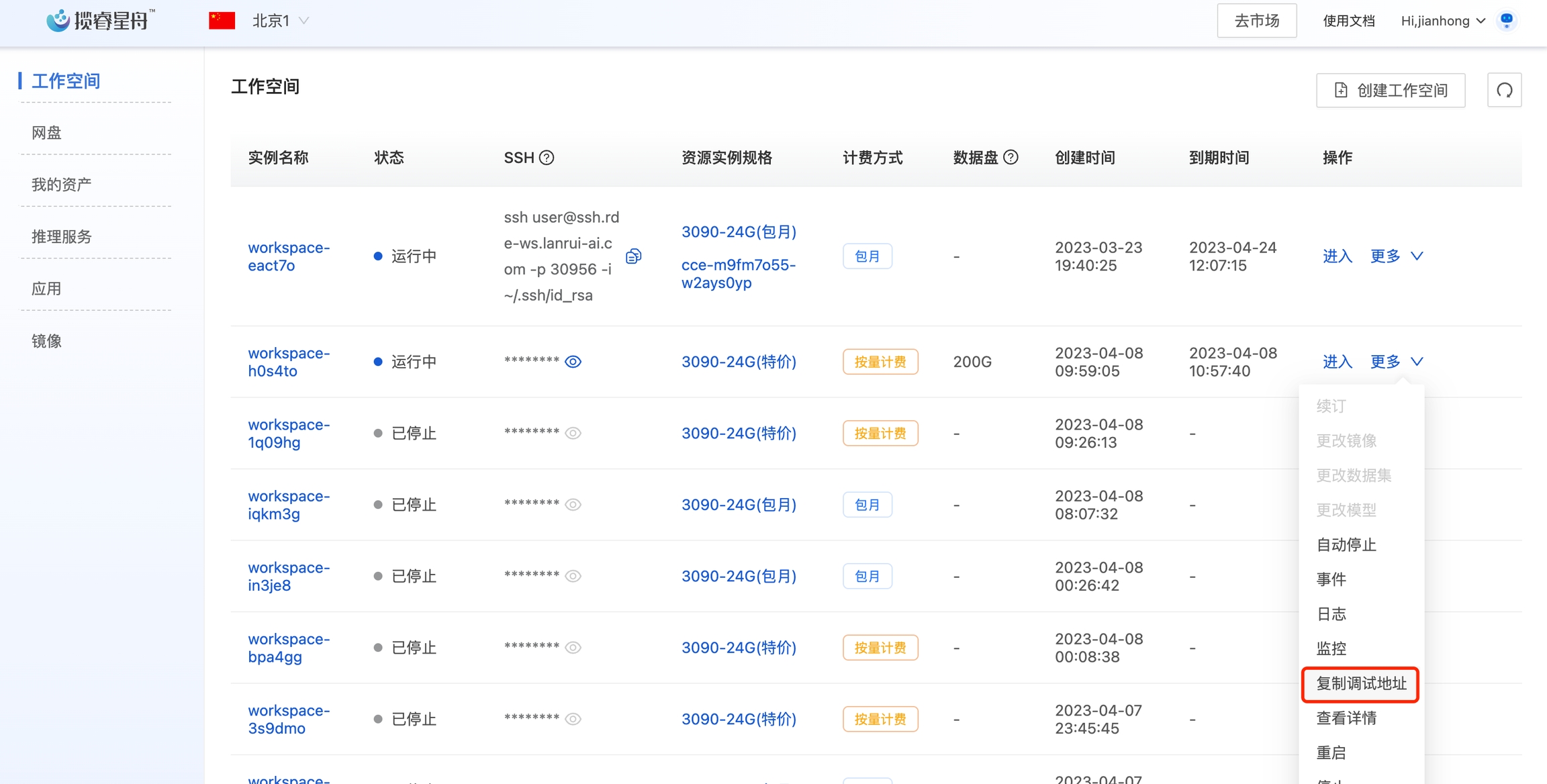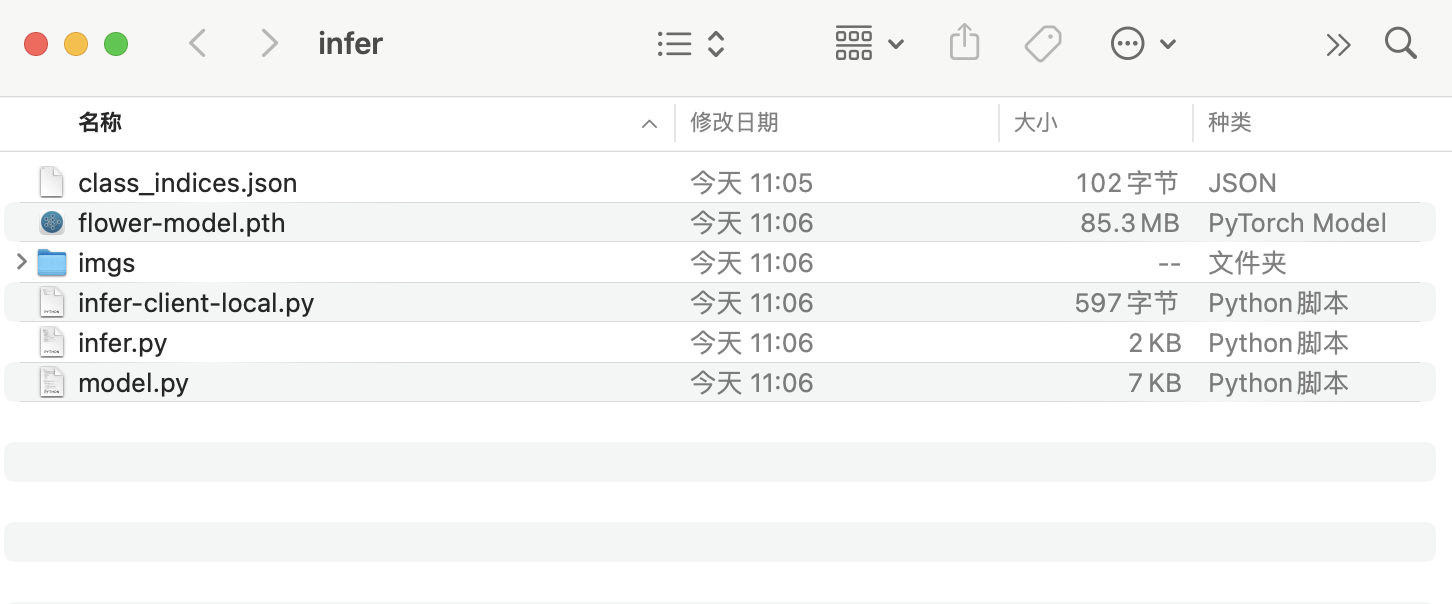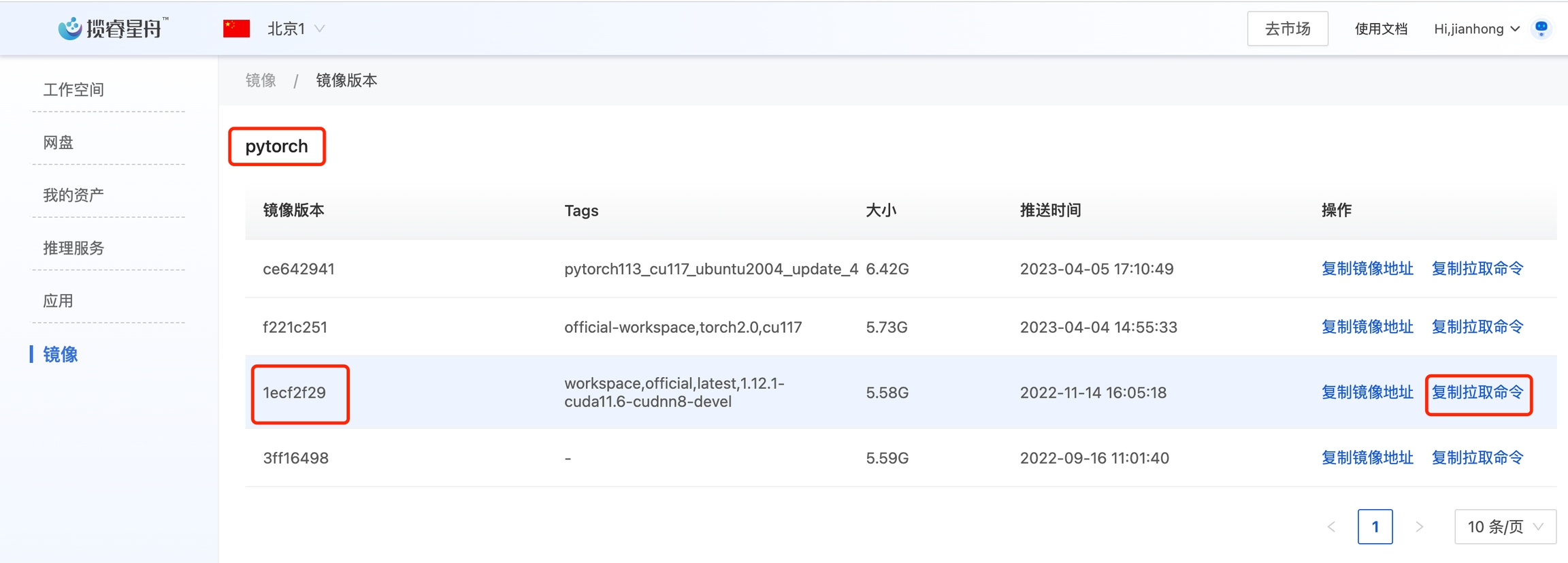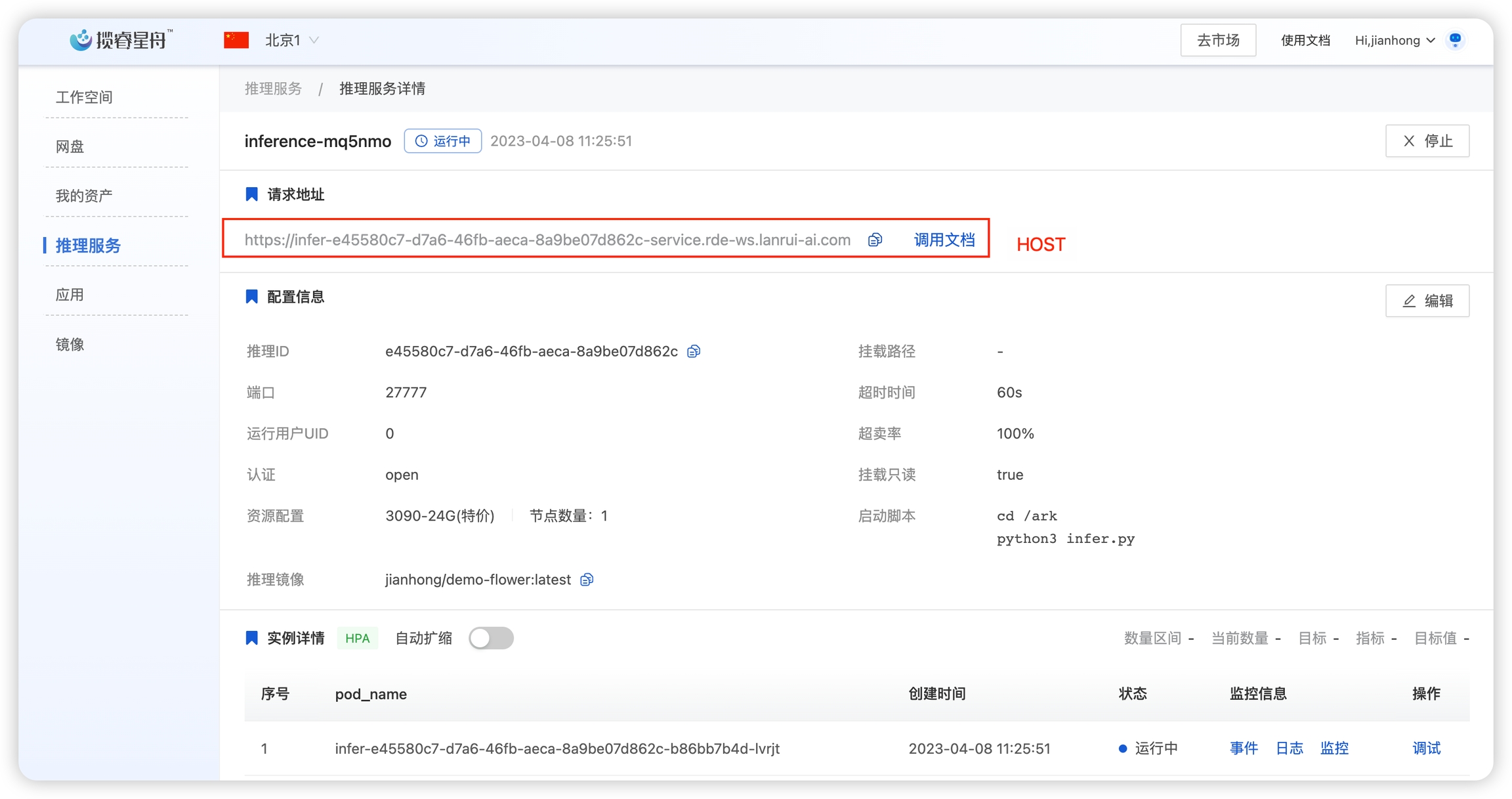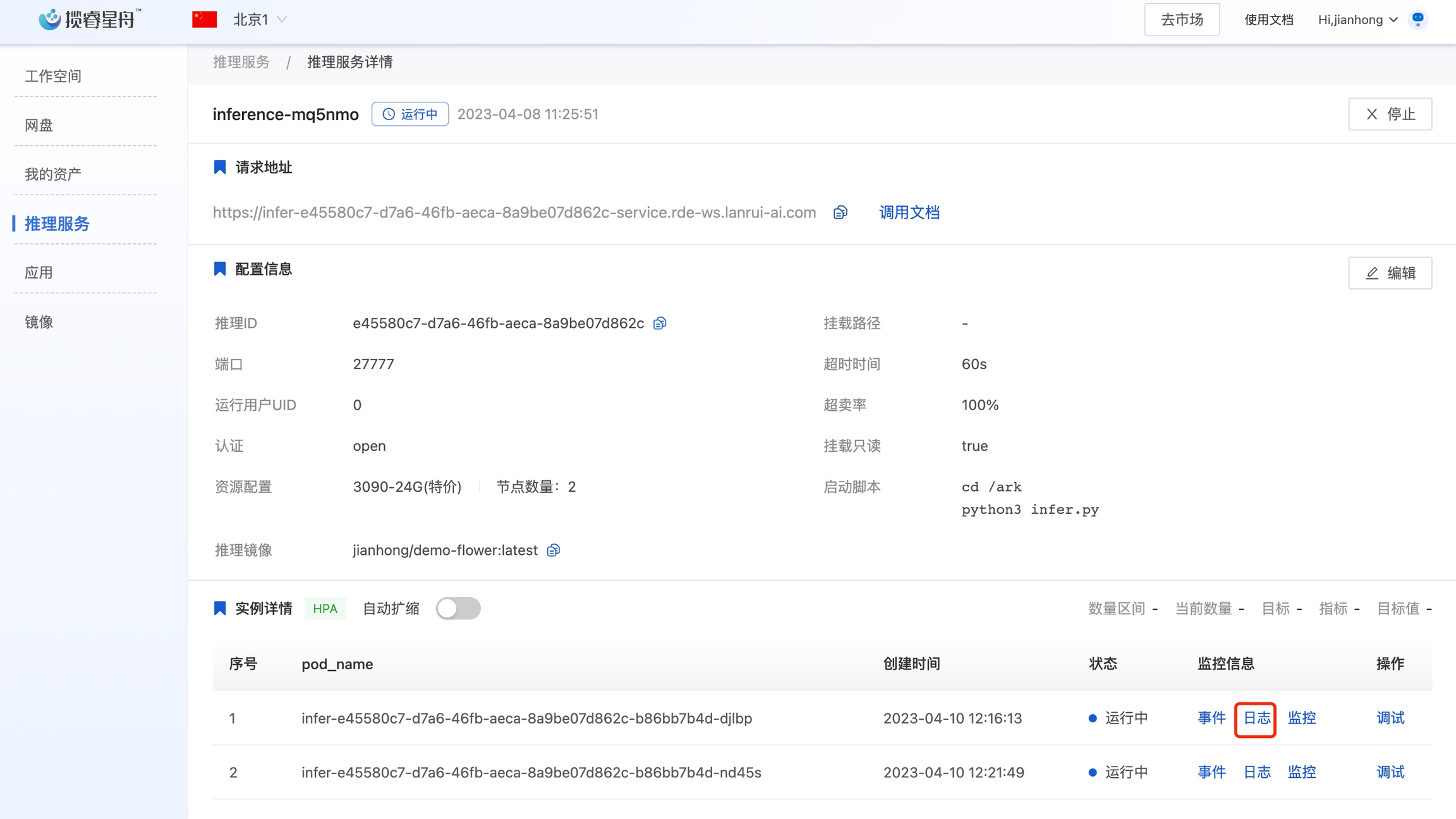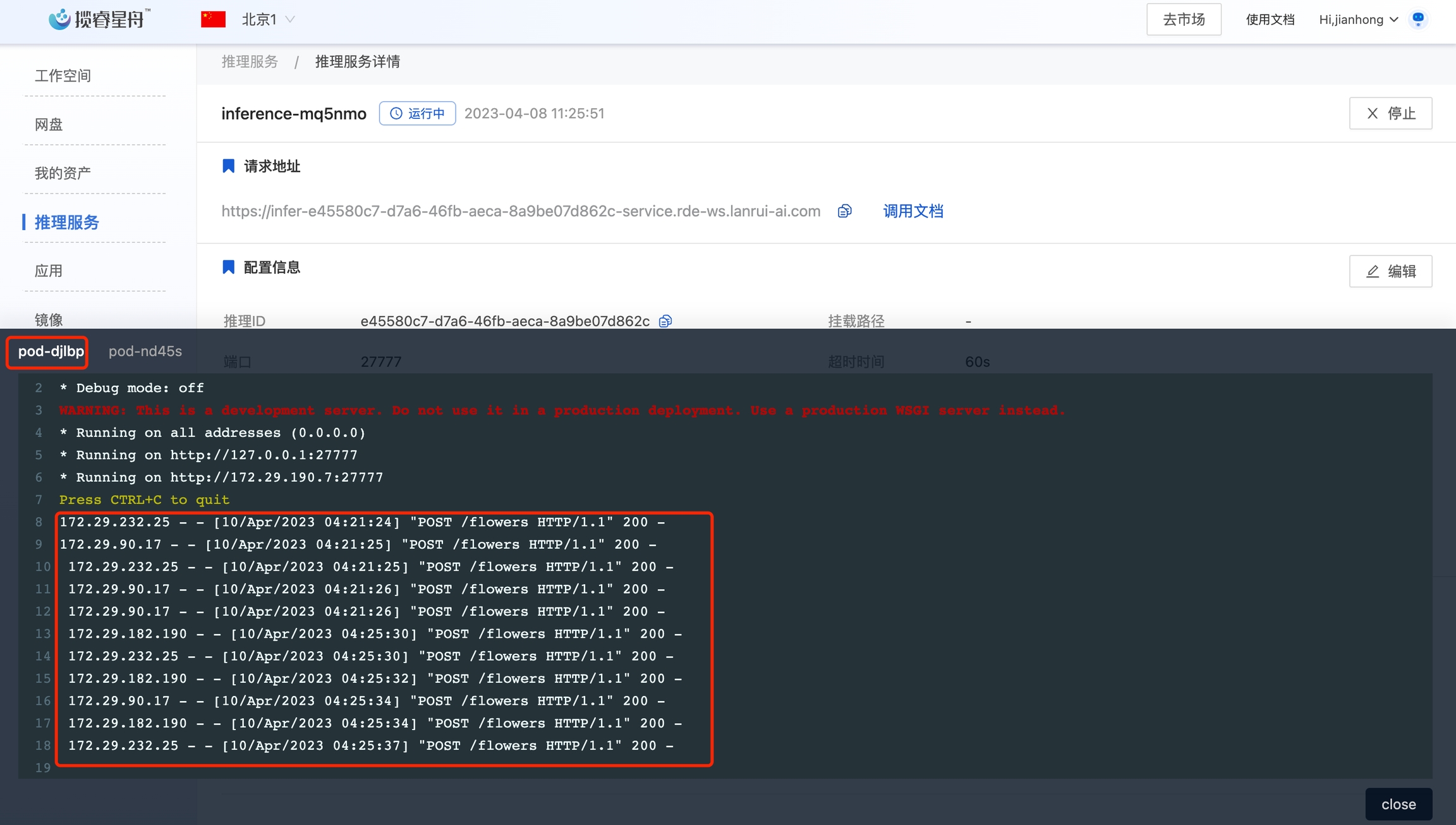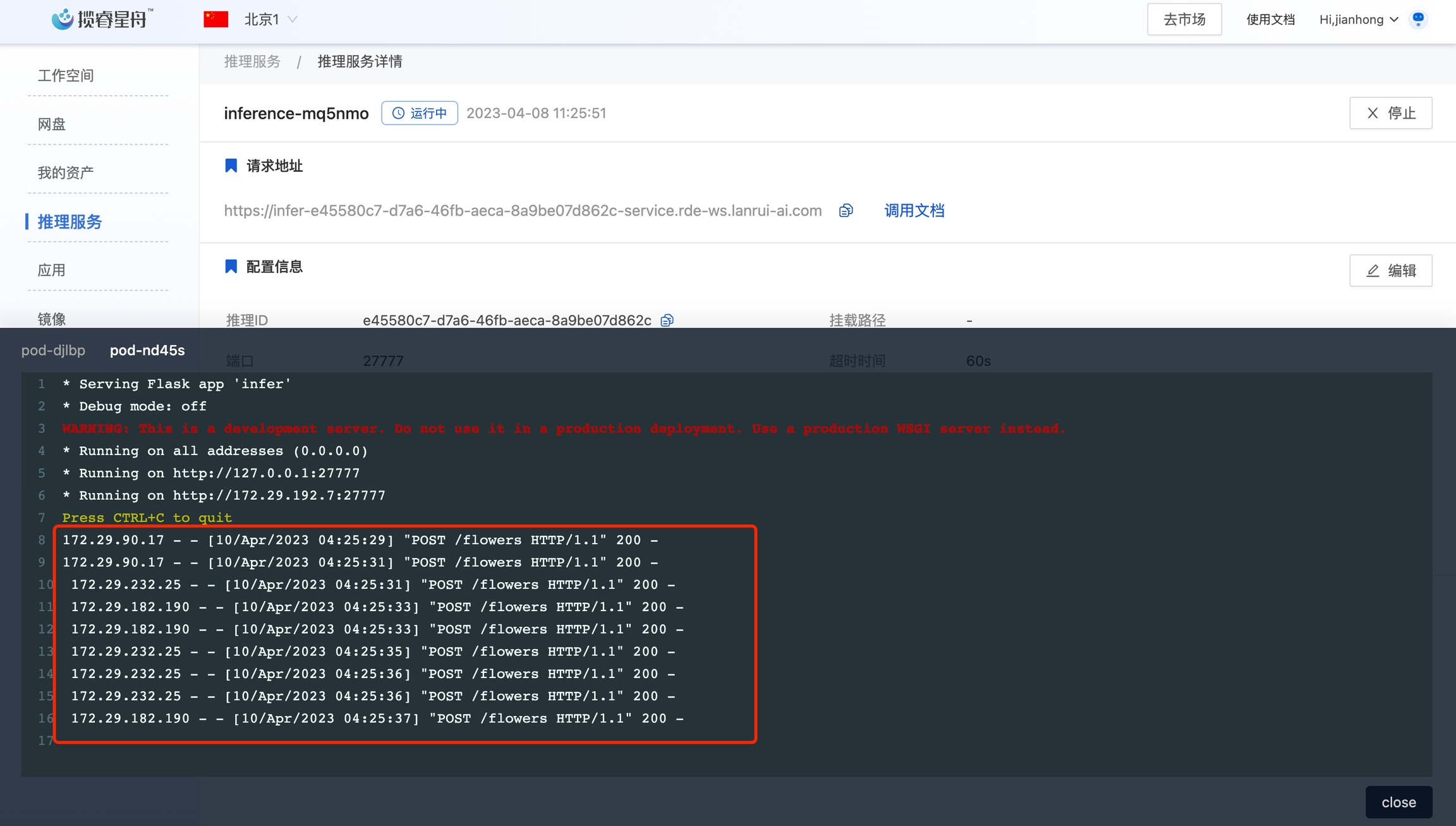1. 概述
平台提供了AI推理解决方案。点击控制台左侧导航栏中的“推理服务”,将会看到已经创建的推理服务列表。点击右上角创建按钮, 选择一种资源实例类型,可以购买按量计费的弹性资源,也可以选择已经购买的包年包月资源,之后设置推理服务的docker镜像, 设置对外暴露的端口,以及服务启动的脚本。推理服务的模型可以打包在镜像内,也可以选择模型市场上的模型,或者用户网盘中指定的模型文件,设置模型挂载的路径,点击创按钮,就可以启动一个推理服务实例。
2. 认证
推理服务默认会启动基于AKSK的签名认证机制,AKSK可以点击平台右上角的头像,进入设置页面,点击AKSK Tab进行查看
下面给出一段构建签名请求的例子代码:
import requests
import json
import base64
import hashlib
import hmac
from datetime import datetime
HOST = "XXX" #Change this to your HOST.
METHOD = "GET" #Change this to your METHOD.
URL = "/" #Change this to your URL
BODY = "" #Change this to your BODY.
CREDENTIAL = "" #Change this to your CREDENTIAL.
SECRET = "" #Change this to your SECRET.
def sign_request(host,
method, # GET, PUT, POST, DELETE
url, # Path + Query
body, # Request body
credential, # Access Key ID
secret): # Access Key Value
verb = method.upper()
utc_now = str(datetime.utcnow().strftime("%a, %d %b %Y %H:%M:%S ")) + "GMT"
content_digest = hashlib.sha256(bytes(body, 'utf-8')).digest()
content_hash = base64.b64encode(content_digest).decode('utf-8')
# Signed Headers
signed_headers = "date;host;x-ark-content-sha256" # Semicolon separated header names
# String-To-Sign
string_to_sign = verb + '\n' + \
url + '\n' + \
utc_now + ';' + host + ';' + content_hash # Semicolon separated SignedHeaders values
decoded_secret = base64.b64decode(secret, validate=True)
digest = hmac.new(decoded_secret, bytes(
string_to_sign, 'utf-8'), hashlib.sha256).digest()
# Signature
signature = base64.b64encode(digest).decode('utf-8')
# Result request headers
return {
"date": utc_now,
"x-ark-content-sha256": content_hash,
"Authorization": "HMAC-SHA256 Credential=" + credential + "&SignedHeaders=" + signed_headers + "&Signature=" + signature
}
on
if __name__ == '__main__':
headers = sign_request(HOST,
METHOD,
URL,
BODY,
CREDENTIAL,
SECRET)
print(headers)
resp = requests.get("https://"+HOST, headers=headers)
print(resp.status_code)
如果需要关闭,可以在创建推理服务的高级配置中,选择关闭认证。关闭认证后,任何人都可以通过推理服务的Endpoint(请求地址)访问该服务。所以用户也可以通过创建关闭认证的推理服务,快速搭建一个简单的Web服务。
3. 手动扩缩容
推理服务提供手动扩缩容的功能。用户可以在推理服务列表中看到实例数量,点击数量后面的详情后,可以手动调整目标节点数及其配置。点击小笔头可以修改扩缩容配置,包括手动设置Pod的数量。
4. 例子
在快速开始的例子中,我们基于resnet34训练了一个5分类花卉的模型,这里我们想在平台上把这个模型构建一个推理服务。
4.1 工作空间调试
在工作空间内,创建一个infer目录,把刚才训练得到的模型权重文件,以及依赖的模型文件和分类文件拷贝进去
mkdir ~/infer
cd ~/infer
cp deep-learning-for-image-processing/pytorch_classification/Test5_resnet/model.py .
cp deep-learning-for-image-processing/pytorch_classification/Test5_resnet/class_indices.json .
cp deep-learning-for-image-processing/pytorch_classification/Test5_resnet/resNet34.pth flower-model.pth
然后参考deep-learning-for-image-processing/pytorch_classification/Test5_resnet/中的infer.py,在infer目录下编写一个flask版本的推理脚本infer.py如下:
import torch
from PIL import Image
from torchvision import transforms
import matplotlib.pyplot as plt
from model import resnet34
from flask import Flask,request
import os,json
app = Flask(__name__)
@app.route("/flowers",methods=['POST'])
def main():
data_transform = transforms.Compose(
[transforms.Resize(256),
transforms.CenterCrop(224),
transforms.ToTensor(),
transforms.Normalize([0.485, 0.456, 0.406], [0.229, 0.224, 0.225])])
image = request.files.get('content')
img = Image.open(image.stream)
img = data_transform(img)
img = torch.unsqueeze(img, dim=0)
with torch.no_grad():
# predict class
output = torch.squeeze(model(img.to(device))).cpu()
predict = torch.softmax(output, dim=0)
predict_cla = torch.argmax(predict).numpy()
print_res = "class: {} prob: {:.3}".format(class_indict[str(predict_cla)],
predict[predict_cla].numpy())
for i in range(len(predict)):
print("class: {:10} prob: {:.3}".format(class_indict[str(i)],
predict[i].numpy()))
return class_indict[str(predict_cla)]
if __name__ == '__main__':
device = torch.device("cuda:0" if torch.cuda.is_available() else "cpu")
json_path = './class_indices.json'
assert os.path.exists(json_path), "file: '{}' dose not exist.".format(json_path)
with open(json_path, "r") as f:
class_indict = json.load(f)
model = resnet34(num_classes=5).to(device)
weights_path = "./flower-model.pth"
assert os.path.exists(weights_path), "file: '{}' dose not exist.".format(weights_path)
model.load_state_dict(torch.load(weights_path, map_location=device))
model.eval()
app.run(host='0.0.0.0',port=27777)
然后我们编写一个本地测试客户端(infer-client-local.py),实例代码如下。注意HOST是工作空间的调试地址(在工作空间的操作列中找到复制调试地址)
import requests
from os.path import isfile, join
from os import listdir
import sys
HOST = XXXX
URL_PATH = '/flowers'
def local_run(files):
response = requests.post(HOST+URL_PATH,files=files)
data = response.text
return data
if __name__ == '__main__':
test_dirs = sys.argv[1]
for image in listdir(test_dirs):
image_path = join(test_dirs, image)
if isfile(image_path):
files= [('content', (image,open(image_path,'rb'),'image/jpeg'))]
print(image,local_run(files))
我们创建一个imgs目录,随便复制几个测试图片到该目录,然后启动测试
mkdir imgs
cp ~/deep-learning-for-image-processing/data_set/flower_data/val/daisy/13901930939_a7733c03f0_n.jpg imgs/
cp ~/deep-learning-for-image-processing/data_set/flower_data/val/dandelion/13290033_ebd7c7abba_n.jpg imgs/
cp ~/deep-learning-for-image-processing/data_set/flower_data/val/roses/123128873_546b8b7355_n.jpg imgs/
cp ~/deep-learning-for-image-processing/data_set/flower_data/val/sunflowers/175638423_058c07afb9.jpg imgs/
cp ~/deep-learning-for-image-processing/data_set/flower_data/val/tulips/112334842_3ecf7585dd.jpg imgs/
python3 infer.py
python3 infer-client-local.py imgs/
可以看到正常输出:
user@lsp-ws:~/infer$ python3 infer-client-local.py imgs/
13901930939_a7733c03f0_n.jpg daisy
123128873_546b8b7355_n.jpg roses
13290033_ebd7c7abba_n.jpg dandelion
112334842_3ecf7585dd.jpg daisy
175638423_058c07afb9.jpg sunflowers
4.2 构建推理镜像并推送到平台镜像仓库
测试无误后,我们可以将推理服务打包成Docker镜像,推送到平台的镜像仓库。建议构建镜像时,从平台的公共镜像开始。推送命令参见控制台-镜像-查看推送命令。
下面是笔者在本地mac M1芯片上的操作步骤,供参考:
如果文件不大,可以在jupyter或者vscode中选中文件直接下载。如果文件较大,可以把文件复制到网盘后,使用网盘的下载命令行工具下载。这里我们直接从vscode下载所需的文件,即上一步中infer目录。
问了减小风险,dockerfile 基于平台的pytorch公共镜像进行构建,下面给出参考的Dockerfile文件。
FROM reg.lanrui-ai.com/ark-public/pytorch@sha256:1ecf2f29cdc91c7ffc69589dc38139217944c0f42fff0e3994f8c57fda924ebe
RUN pip3 install flask
COPY flower-model.pth /ark/
COPY model.py /ark/
COPY class_indices.json /ark/
COPY infer.py /ark/
EXPOSE 5000
CMD ["python3","infer.py"]
docker pull reg.lanrui-ai.com/ark-public/pytorch@sha256:1ecf2f29cdc91c7ffc69589dc38139217944c0f42fff0e3994f8c57fda924ebe
docker buildx build -f Dockerfile --platform=linux/amd64 -t demo-flower -f Dockerfile .
docker tag demo-flower reg.lanrui-ai.com/<username>/demo-flower
docker push reg.lanrui-ai.com/<username>/demo-flower
注意:
上面的<username>是用户在平台的用户名,即平台右上角头像旁边显示的字符串(Hi后面的)
第一条命令是从平台上获取pytorch的官方镜像,可以参考下图,点击复制拉取命令获得
推送成功后,可以在平台的镜像-私有镜像中看到demo-flower镜像
4.3 创建推理服务
在控制台-推理服务,创建推理服务。选择一台GPU机器,设置如下(端口27777是因为我们代码中对外服务的端口是27777),点击创建。
4.4 编写客户端脚本
待推理服务启动后,我们在本地编写一个客户端脚本infer-client.py,和上面的本地测试客户端相比,加上了AKSK的鉴权机制。 注意填写脚本中HOST, AK和SK。其中HOST是推理服务的请求地址,AK和SK可以在平台右上角点击个人头像-设置-AKSK中获取。
import requests
import base64,hashlib,hmac,os
from datetime import datetime
import time,threading,multiprocessing,os
from multiprocessing import Process,Pool
from os.path import isfile, join
from os import listdir
import sys
HOST = ''
AK = ''
SK = ''
URL_PATH = '/flowers'
def sign_request(host,
method, # GET, PUT, POST, DELETE
url, # Path + Query
body, # Request body
credential, # Access Key ID
secret): # Access Key Value
verb = method.upper()
utc_now = str(datetime.utcnow().strftime("%a, %d %b %Y %H:%M:%S ")) + "GMT"
content_digest = hashlib.sha256(bytes(body, 'utf-8')).digest()
content_hash = base64.b64encode(content_digest).decode('utf-8')
signed_headers = "date;host;x-ark-content-sha256" # Semicolon separated header names
string_to_sign = verb + '\n' + \
url + '\n' + \
utc_now + ';' + host + ';' + content_hash # Semicolon separated SignedHeaders values
decoded_secret = base64.b64decode(secret, validate=True)
digest = hmac.new(decoded_secret, bytes(
string_to_sign, 'utf-8'), hashlib.sha256).digest()
signature = base64.b64encode(digest).decode('utf-8')
return {
"date": utc_now,
"x-ark-content-sha256": content_hash,
"Authorization": "HMAC-SHA256 Credential=" + credential + "&SignedHeaders=" + signed_headers + "&Signature=" + signature
}
def run(files):
headers = None
headers = sign_request(HOST.split('https://')[1],
"POST",
URL_PATH,
"",
AK,
SK)
response = requests.post(HOST+URL_PATH,headers=headers,files=files)
data = response.text
return data
if __name__ == '__main__':
test_dirs = sys.argv[1]
for image in listdir(test_dirs):
image_path = join(test_dirs, image)
if isfile(image_path):
files= [('content', (image,open(image_path,'rb'),'image/jpeg'))]
print(image,run(files))
执行后可以看到成功了
python infer-client.py imgs
13290033_ebd7c7abba_n.jpg dandelion
175638423_058c07afb9.jpg sunflowers
123128873_546b8b7355_n.jpg roses
112334842_3ecf7585dd.jpg daisy
13901930939_a7733c03f0_n.jpg daisy
4.5 扩缩容
当前的推理服务只有一个实例,存在单点风险。我们可以扩容为两个节点。点击实例数量后面的详情,选择手动扩缩容, 修改实例数量为2,点击确定。
设置完成后,进入实例详情中,可以看到已经有两个实例了。等第二个实例启动后,我们可以用4.4的测试代码请求多次。在监控信息的日志里,可以看到请求被负载均衡到两个实例了。
Last updated




